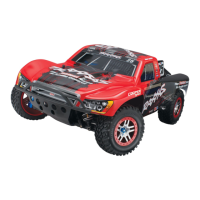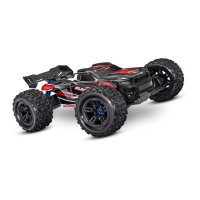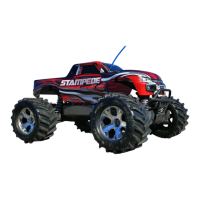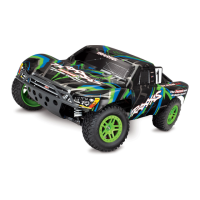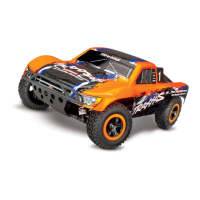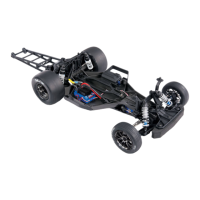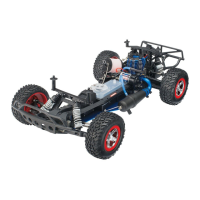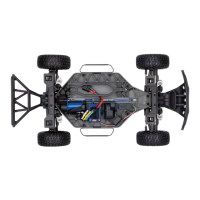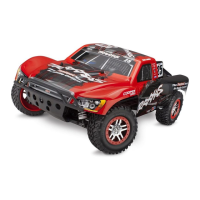Do you have a question about the Traxxas SUMMIT 72054-5-RNR and is the answer not in the manual?
Information on contacting Traxxas for support and available options.
Guide to get the model up and running quickly, directing to page 9.
Instructions to register your product online for better customer service.
Regulatory compliance information for digital devices and radio frequency.
Explanation of icons used in the manual for warnings, tips, and cross-references.
Contact information and resources for Traxxas technical support and service.
Key safety advice for operating the model, including location and crowd restrictions.
Precautions for handling the electronic speed control, batteries, and connectors.
Information and encouragement to recycle Traxxas Power Cell NiMH batteries.
Critical warnings and precautions for handling Lithium Polymer (LiPo) batteries.
Precautions for charging and handling all types of batteries, including LiPo and NiMH.
Further safety advice for charging, storing, and using batteries, including car charging.
List of specialty metric tools included with the model.
Suggested additional tools and supplies for an R/C toolbox.
Essential equipment not included, such as AA batteries.
Diagram labeling key parts of the 1/16 Summit model.
Outline of steps to get the model running, with references to other manual sections.
Emphasizes that the guide is not a replacement for the full manual.
Instructions for applying optional decals to the model.
Overview of the automatic frequency selection and ease of use.
Definitions of key terms related to the radio and power systems.
Definitions of transmitter, trim, thermal shutdown, 2-channel system, and voltage.
Crucial advice on antenna handling to prevent loss of radio range.
Schematic showing the wiring connections for the ESC, motor, and battery.
Diagram illustrating the connections between transmitter, receiver, servo, ESC, and motor.
Detailed view of the XL-2.5 ESC components and connectors.
Procedure for installing 4 AA batteries into the transmitter.
Instructions for charging the included NiMH battery pack with the Traxxas charger.
Information on Traxxas Battery iD and using rechargeable batteries in the transmitter.
Steps to properly install the receiver antenna and tube for optimal range.
Explanation of Traxxas Battery iD for automatic charger recognition.
Procedure for installing the 7.2-volt battery pack in the model's compartment.
Description of the Traxxas connector for efficient power transfer.
Guidance on using LiPo batteries and connecting two batteries in parallel.
Identification of transmitter controls like steering wheel, throttle, and trim.
Essential rules for safe operation, including transmitter on/off order and battery use.
Procedures for adjusting steering trim and reversing channels.
How to use the throttle trigger for forward, brake, reverse, and neutral.
Steps for turning on the system, checking controls, and ensuring proper servo operation.
Procedure to test radio system range and responsiveness before driving.
Advice on maintaining radio range at higher speeds and safe driving practices.
Steps to electronically 'bind' the transmitter and receiver if needed.
Explanation of transmitter LED colors and patterns for status indication.
Explanation of receiver LED colors and patterns for status indication.
Description of the built-in failsafe that returns throttle to neutral on signal loss.
Technical specifications for the XL-2.5 electronic speed control.
How to activate or disable Low-Voltage Detection for LiPo or NiMH batteries.
Procedure for calibrating the ESC with the transmitter.
How to operate the speed control and test its functions.
Steps to select Sport, Race, or Training Mode for the ESC.
Explanation of ESC LED indicators for status, protection, and errors.
Important safety and care tips for operating the model, including cooling and battery checks.
Advice on maximizing run time through battery choice, gearing, and maintenance.
Explanation of how battery capacity affects performance and voltage drop.
Information on the model's water-resistant features and precautions for wet operation.
Specific warnings about transmitter, salt water, and motor use in wet environments.
Steps to prepare the model for wet conditions, including tire modification.
Procedures for cleaning, drying, and protecting the model after wet use.
Maintenance steps for bearings, differentials, transmission, and motor.
Instructions for removing and installing the receiver while maintaining the box's seal.
How to adjust ride height using threaded shock bodies.
Explanation of shock oil viscosity's effect on damping and its temperature dependence.
Step-by-step guide for disassembling shocks and changing the oil.
How to adjust static camber using pivot balls and factory settings.
Procedure for adjusting the slipper clutch to prevent drivetrain stress.
How differential fluid viscosity affects performance and traction.
Guide to understanding and changing gear ratios for performance tuning.
Steps for accessing and removing the motor for gearing adjustments.
Procedure for installing a new pinion gear onto the motor shaft.
How to set correct gear mesh to prevent stripped spur gears.
Chart showing suitable gear combinations for the model.
Information on using aftermarket wheels and tires and their impact on the model.
Checklist for inspecting the model for cracked parts, binding, and loose connections.
Regular maintenance tasks like checking slipper clutch and motor lubrication.
Cleaning the chassis and ensuring proper oil levels in the shocks.
Inspecting suspension components and the driveline for wear and binding.
Instructions for storing the model and transmitter safely when not in use.
The Traxxas 1/16 Summit is a high-performance, radio-controlled monster truck designed for off-road driving. It combines several Traxxas innovations, including F1-inspired, rocker-actuated suspension, waterproof electronics, and a monocoque-style chassis, all contributing to its speed, power, and handling. This model is intended for users with a skill level of 1, meaning no previous experience with radio-controlled models is required, though some setup, maintenance, and support equipment are necessary.
The 1/16 Summit is an electric-powered, 2-channel radio-controlled vehicle. The TQ 2.4GHz radio system controls both steering and throttle. The electronic speed control (ESC), an XL-2.5, manages motor power efficiently, extending battery life and preventing loss of control as the battery discharges. The model is equipped with a Titan 12T motor and a transmission that delivers power to all four wheels. Its design allows for versatile driving across various terrains, including wet conditions, thanks to its water-resistant electronics. The vehicle's suspension system, featuring oil-filled shocks, helps absorb bumps and maintain stability. The adjustable slipper clutch protects the drivetrain from over-stressing and can be tuned to regulate power delivery to the wheels, preventing excessive tire spin. The sealed gear differentials allow the left and right wheels to spin at different speeds during turns, improving cornering and reducing tire scuffing.
The TQ 2.4GHz transmitter automatically locks onto an available frequency, allowing multiple models to be raced without interference. Before operation, users must install 4 AA batteries in the transmitter and charge the included 6-cell 2/3A NiMH battery pack using the provided charger. The receiver antenna must be properly installed in the antenna tube to ensure maximum radio range. The model's battery compartment is designed for easy access, and the battery should be installed with wires facing the rear and routed through a designated slot to prevent pinching.
The XL-2.5 ESC features Low-Voltage Detection, which is crucial when using LiPo batteries to prevent over-discharging. This feature is disabled by default for NiMH batteries but can be activated for LiPo packs. The ESC also offers different driving profiles: Sport Mode (100% forward, 100% brakes, 100% reverse), Race Mode (100% forward, 100% brakes, no reverse), and Training Mode (50% forward, 100% brakes, 50% reverse), allowing users to adjust power output based on skill level or driving conditions. Training Mode is particularly useful for beginners to gain better control.
For optimal performance, the radio system should be range-tested before each use. The transmitter should always be turned on first and off last to prevent runaway incidents. The steering trim on the transmitter allows for fine-tuning the neutral position of the steering servo, ensuring the wheels point straight when the steering wheel is centered. The model is designed to run in wet conditions, but additional precautions and maintenance are required. Users should cut small holes in the tires to allow water to drain and avoid operating in saltwater or during lightning storms.
Regular maintenance is essential to keep the 1/16 Summit in top running condition. This includes inspecting for cracked, bent, or damaged parts, checking wheel and steering binding, and verifying shock absorber operation. All wiring, connections, and mounting of the receiver and servos should be checked for tightness and integrity. Wheel nuts and other chassis screws should be periodically tightened.
The slipper clutch pad, a friction material, will wear over time and should be replaced if it fails to provide consistent performance. The motor requires cleaning and lubrication every 10-15 runs; an electric motor cleaning spray can flush out dirt, and lightweight motor oil should be applied to the bushings. The chassis should be kept clean of dirt and grime.
Shocks need to be maintained with full oil levels using 100% pure silicone shock oil to prolong seal life. Leakage indicates a need to inspect the bladder or rebuild the shock. The suspension components, such as pins and turnbuckles, should be inspected for damage or bending. The driveline, including drive yokes, axle half shafts, and gears, should be checked for wear and binding.
After running in wet conditions, specific maintenance steps are crucial: draining water from tires, removing the battery, rinsing off dirt and mud with low-pressure water (avoiding bearings and transmission), blowing off the model with compressed air, removing wheels, and spraying bearings, drivetrain, and fasteners with water-displacing oil. The sealed receiver box cover should be removed during storage to allow air drying and prevent moisture buildup, enhancing the receiver's long-term reliability. When storing the model for extended periods, both the main battery and transmitter batteries should be removed.
| Scale | 1/10 |
|---|---|
| Gear Pitch | 32 Pitch |
| Drive System | Shaft-Driven 4WD |
| Radio System | TQi 2.4GHz (4-channel) |
| Charger | Not Included |
| Motor | Titan 775 |
| Transmission | Two-Speed |
| Drive Type | 4WD |
| Battery Type | 7-cell NiMH or 2-cell LiPo |
| Differential Type | Locking differentials |
| Steering | Dual servo |
| Battery | 7-cell NiMH or 2-cell LiPo |
| Tire Type | Canyon AT |
| Chassis Structure/Material | Composite tub chassis |
| Chassis | Composite tub chassis |
